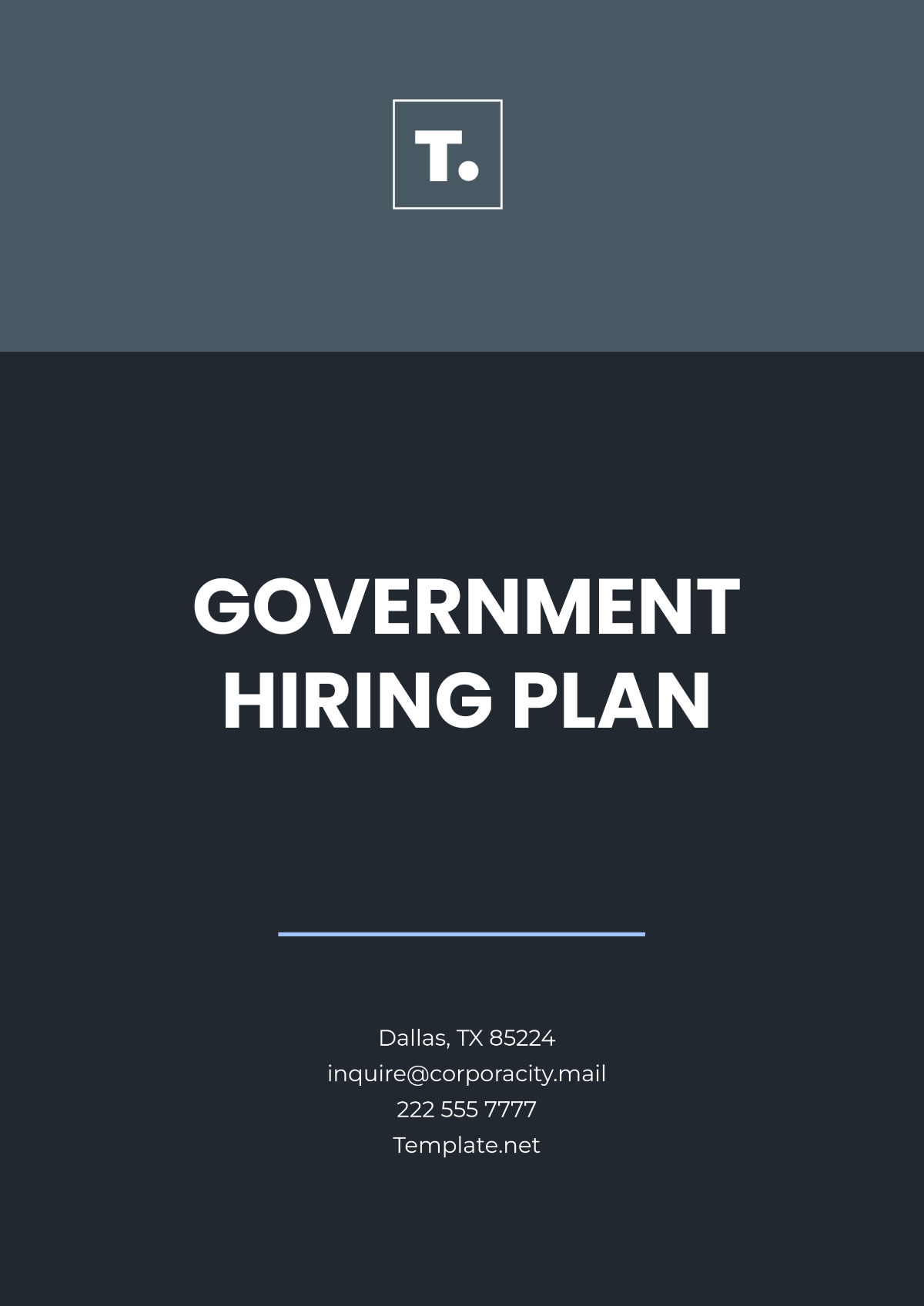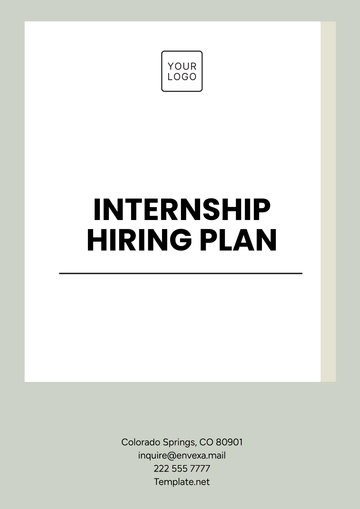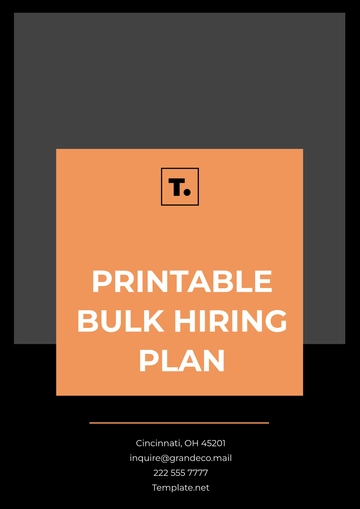Free Government Hiring Plan

Prepared By:
Human Resources Department
[Your Company Name]
Introduction
At [Your Company Name], we understand the critical importance of a strategic and structured approach to government hiring. The Government Hiring Plan is designed to guide our recruitment processes, ensuring we attract, evaluate, and select the most qualified candidates while maintaining transparency, fairness, and adherence to regulatory requirements. Our goal is to build a workforce that not only meets the immediate needs of the agency but also supports its long-term objectives, values, and mission.
This Hiring Plan is tailored to align with the agency’s strategic goals, ensuring that we hire individuals who possess the necessary skills, experience, and cultural fit. The plan also emphasizes diversity, equity, and inclusion throughout the recruitment process, providing equal opportunities to all candidates.
Objectives
The key objectives of this Government Hiring Plan include:
Ensuring Fairness: Establishing an unbiased and standardized hiring process that promotes equal opportunity.
Meeting Staffing Needs: Aligning our hiring efforts with the agency's evolving staffing requirements to support day-to-day operations and strategic goals.
Promoting Diversity and Inclusion: Integrating initiatives to increase representation and create a more inclusive workforce.
Maintaining Compliance: Ensuring that every recruitment process complies with relevant federal, state, and local laws and regulations.
Key Components
1. Workforce Analysis
Current Workforce Review: We begin by evaluating the existing workforce to identify gaps, assess skills, and determine immediate and future staffing needs.
Forecasting Future Needs: By collaborating with department heads, we project hiring needs based on upcoming projects, retirements, and strategic initiatives.
Diversity and Inclusion Goals: We develop and track specific diversity goals, ensuring that recruitment efforts are targeted toward building a more inclusive workforce.
2. Job Descriptions and Specifications
Position Requirements: We collaborate with department managers to define the qualifications, competencies, and responsibilities for each position. These are articulated clearly in the job descriptions to ensure that all candidates understand the expectations for the role.
Job Classifications: Jobs are classified based on skill sets, responsibilities, and salary ranges, maintaining consistency across all departments.
Key Performance Indicators (KPIs): For each position, we establish success metrics that align with the agency’s goals, helping to assess the effectiveness of our recruitment efforts.
3. Recruitment Strategy
Sourcing Channels: We identify the most appropriate platforms for advertising job openings, such as government job boards, local community networks, and professional associations, ensuring a diverse candidate pool.
Outreach Programs: We design outreach strategies to engage candidates from diverse backgrounds, including underrepresented groups, veterans, and individuals with disabilities.
Job Postings: All job advertisements are written to be clear, transparent, and inclusive, emphasizing qualifications, responsibilities, and the benefits of working with the agency.
4. Selection Process
Application Review: We establish clear criteria for reviewing candidate applications, ensuring each applicant is evaluated based on their qualifications and experience.
Interviews: We use structured interview formats, focusing on assessing competencies, technical skills, and alignment with the agency's mission. Interview panels are trained to mitigate bias and evaluate candidates fairly.
Skills Testing: Where applicable, candidates may undergo job-specific assessments to demonstrate their practical abilities in real-world scenarios.
Reference Checks: To verify the qualifications and suitability of candidates, we conduct thorough reference checks, ensuring the candidate’s experience and skills match the requirements.
5. Diversity and Inclusion Strategies
Targeted Recruitment: We actively reach out to diverse communities to encourage applications from women, minorities, veterans, and individuals with disabilities.
Bias Mitigation Training: All hiring personnel receive training on recognizing and reducing unconscious bias throughout the recruitment and selection process.
Affirmative Action: We maintain an affirmative action strategy to meet diversity goals and ensure equitable opportunities for all candidates.
6. Timeline and Milestones
Job Posting Duration: Job postings will remain open for a set period to ensure sufficient time for candidates to apply, typically 30 days.
Selection Process: The hiring process, including resume screening, interviews, and final decision-making, will occur within a defined timeframe, usually between 30 and 60 days.
Onboarding: Once a candidate is selected, we ensure a smooth onboarding process to help them integrate into the agency quickly and effectively, with the appropriate training and orientation.
7. Compliance and Reporting
Legal Adherence: All hiring processes comply with the relevant legal and regulatory requirements, including Equal Employment Opportunity (EEO) guidelines, the Americans with Disabilities Act (ADA), and other applicable laws.
Recordkeeping: Detailed records are maintained throughout the hiring process, including applications, interview notes, and selection decisions, ensuring compliance with federal and state record-keeping laws.
Reporting: Regular reports are generated to track the progress of the hiring process, including diversity metrics and other key performance indicators, ensuring transparency and accountability.
8. Budget and Resources
Recruitment Budget: We work with the agency’s budget office to allocate sufficient funds for recruitment activities, including advertising, testing, and outreach efforts.
Staffing Resources: We ensure that the HR department is adequately staffed and supported with the resources needed to carry out the recruitment process smoothly and effectively.
9. Monitoring and Evaluation
Ongoing Feedback: After each recruitment cycle, we assess the process and gather feedback from hiring managers and candidates to identify opportunities for improvement.
Performance Metrics: We track key indicators such as time-to-fill, candidate quality, and diversity outcomes, using this data to adjust future recruitment strategies.
Continuous Improvement: The recruitment process is regularly reviewed and refined based on feedback, performance metrics, and changes in agency needs.
Conclusion
The Government Hiring Plan serves as the foundation for our recruitment strategy, ensuring that we hire the best candidates while adhering to all legal and regulatory standards. By maintaining a focus on fairness, diversity, and compliance, we can build a workforce that effectively supports the agency’s mission and goals. Through careful planning, continuous evaluation, and a commitment to improvement, we ensure that our hiring practices are transparent, efficient, and aligned with the needs of our community and workforce.
- 100% Customizable, free editor
- Access 1 Million+ Templates, photo’s & graphics
- Download or share as a template
- Click and replace photos, graphics, text, backgrounds
- Resize, crop, AI write & more
- Access advanced editor
The Government Hiring Plan Template from Template.net is an editable and customizable tool designed for efficient public sector recruitment. Tailor the template to meet specific government hiring needs with ease. Fully editable in our AI Editor Tool, this template offers flexibility and simplifies the process, ensuring a smooth and streamlined recruitment experience.
You may also like
- Finance Plan
- Construction Plan
- Sales Plan
- Development Plan
- Career Plan
- Budget Plan
- HR Plan
- Education Plan
- Transition Plan
- Work Plan
- Training Plan
- Communication Plan
- Operation Plan
- Health And Safety Plan
- Strategy Plan
- Professional Development Plan
- Advertising Plan
- Risk Management Plan
- Restaurant Plan
- School Plan
- Nursing Home Patient Care Plan
- Nursing Care Plan
- Plan Event
- Startup Plan
- Social Media Plan
- Staffing Plan
- Annual Plan
- Content Plan
- Payment Plan
- Implementation Plan
- Hotel Plan
- Workout Plan
- Accounting Plan
- Campaign Plan
- Essay Plan
- 30 60 90 Day Plan
- Research Plan
- Recruitment Plan
- 90 Day Plan
- Quarterly Plan
- Emergency Plan
- 5 Year Plan
- Gym Plan
- Personal Plan
- IT and Software Plan
- Treatment Plan
- Real Estate Plan
- Law Firm Plan
- Healthcare Plan
- Improvement Plan
- Media Plan
- 5 Year Business Plan
- Learning Plan
- Marketing Campaign Plan
- Travel Agency Plan
- Cleaning Services Plan
- Interior Design Plan
- Performance Plan
- PR Plan
- Birth Plan
- Life Plan
- SEO Plan
- Disaster Recovery Plan
- Continuity Plan
- Launch Plan
- Legal Plan
- Behavior Plan
- Performance Improvement Plan
- Salon Plan
- Security Plan
- Security Management Plan
- Employee Development Plan
- Quality Plan
- Service Improvement Plan
- Growth Plan
- Incident Response Plan
- Basketball Plan
- Emergency Action Plan
- Product Launch Plan
- Spa Plan
- Employee Training Plan
- Data Analysis Plan
- Employee Action Plan
- Territory Plan
- Audit Plan
- Classroom Plan
- Activity Plan
- Parenting Plan
- Care Plan
- Project Execution Plan
- Exercise Plan
- Internship Plan
- Software Development Plan
- Continuous Improvement Plan
- Leave Plan
- 90 Day Sales Plan
- Advertising Agency Plan
- Employee Transition Plan
- Smart Action Plan
- Workplace Safety Plan
- Behavior Change Plan
- Contingency Plan
- Continuity of Operations Plan
- Health Plan
- Quality Control Plan
- Self Plan
- Sports Development Plan
- Change Management Plan
- Ecommerce Plan
- Personal Financial Plan
- Process Improvement Plan
- 30-60-90 Day Sales Plan
- Crisis Management Plan
- Engagement Plan
- Execution Plan
- Pandemic Plan
- Quality Assurance Plan
- Service Continuity Plan
- Agile Project Plan
- Fundraising Plan
- Job Transition Plan
- Asset Maintenance Plan
- Maintenance Plan
- Software Test Plan
- Staff Training and Development Plan
- 3 Year Plan
- Brand Activation Plan
- Release Plan
- Resource Plan
- Risk Mitigation Plan
- Teacher Plan
- 30 60 90 Day Plan for New Manager
- Food Safety Plan
- Food Truck Plan
- Hiring Plan
- Quality Management Plan
- Wellness Plan
- Behavior Intervention Plan
- Bonus Plan
- Investment Plan
- Maternity Leave Plan
- Pandemic Response Plan
- Succession Planning
- Coaching Plan
- Configuration Management Plan
- Remote Work Plan
- Self Care Plan
- Teaching Plan
- 100-Day Plan
- HACCP Plan
- Student Plan
- Sustainability Plan
- 30 60 90 Day Plan for Interview
- Access Plan
- Site Specific Safety Plan
























